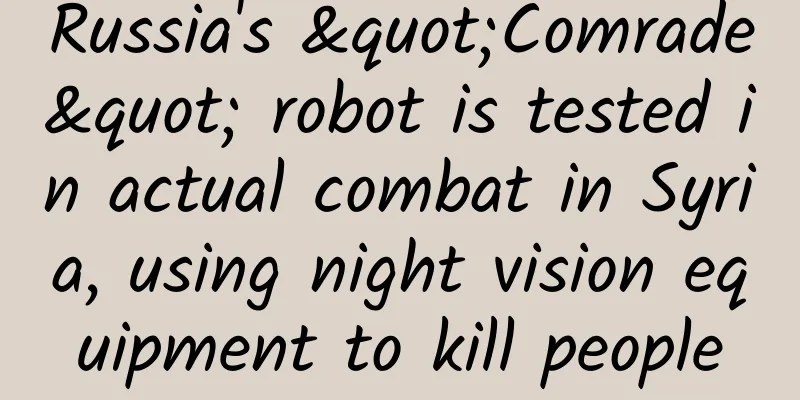Russia's "Comrade" robot is tested in actual combat in Syria, using night vision equipment to kill people

|
Recently, the Russian army released a video of its unmanned combat vehicles fighting in northern Syria. In the video, the BAS-01G "Comrade" unmanned combat robot developed by Kalashnikov Corporation appeared on the battlefield for the first time. This is also the second combat robot sent by the Russian army to the Syrian battlefield after the Uranus 9 combat robot. The Russian army also specially showed the video of the "Comrade" ambushing Turkish-backed militants in northern Syria. During the battle, the "Comrade" took advantage of its night vision equipment and started a killing spree. It suddenly opened fire with a machine gun and caught the militants off guard, eventually annihilating them all. The "comrade" drove off the truck, which was not very large in comparison. The truck also had an operating cabin behind the cab. The Russian army must have considered the problem of one truck pulling one system when designing it. The antenna is raised above the operating compartment, and the truck cab in front and the shed in the rear are visible. The operating table has two operating levers and a small storage box that can be folded down. There is more than one operating table. The author suspects that one is a portable one hanging on the waist and the other is used in the car. Because at present, the "Comrade" is positioned as a squad accompanying support equipment. It must follow the soldiers forward and it is impossible for a car to follow behind. Earlier (around 2017), the Russian army demonstrated the "Comrade" unmanned combat vehicle and its operating equipment in training, similar to the portable type hung on the waist above. The "Comrades" ambushed the militants, which should have been carried out at night through night vision goggles. The militants reacted quickly. They lay down as soon as they were attacked and tried to find a firing point to fight back. However, the "Comrades" were unmanned combat vehicles, so they could not find the "enemy" at all. In addition, the "Comrades" had fierce firepower from machine guns and rockets, which quickly pinned them to the spot and eliminated them. There was a counterattack in the upper left corner, but it was meaningless. The opponent was "not human" and the firepower was very fierce. This group of militants was quickly eliminated. Moreover, they should have been cooperated with Russian soldiers in the battle. The "comrades-in-arms" were supporting firepower and providing night vision guidance. The BAS-01G "Soratnik" unmanned combat vehicle was developed by the Russian Kalashnikov Group. It was first unveiled in September 2016. It weighs 7 tons and uses traditional fuel power. It has a range of 400 kilometers and a maximum speed of 40 kilometers per hour. It can operate within a radius of 10 kilometers (it should be that the vehicle-mounted operating console can reach such a long distance); the weapon combination is optional. It includes 4 anti-tank missiles or fuel-air explosive bombs, a 7.62 or 12.7 mm machine gun, a 30 mm automatic grenade launcher, etc. The "comrade" without weapons can be seen in the middle of the turret with a reserved position for the "main gun" and two twin launchers on the upper part. Russia has used Syria as a weapons testing ground. In addition to Su-57 fighter jets and T-14 tanks, it has also invested a large number of unmanned weapon systems for actual combat testing. The "Uranus" series is Russia's most well-known unmanned ground vehicle, or unmanned combat vehicle, which was put into actual combat in Syria a long time ago. It may be the earliest unmanned combat vehicle put into actual combat. Although some problems have occurred, Russia has improved it in line with the concept of "the sooner the problem appears, the better". Not only is it officially equipped with the Russian army, but a special robot combat unit has also been established. The "Uranus-9" unmanned combat vehicle fighting in Syria, The Uranus-9 weighs 10 tons (some say 12 tons, probably due to batch issues), and is fully armored, with the front being able to withstand 12.7mm ordinary machine gun bullets. The firepower is very strong, with a 2A72 30mm cannon, a PKT 7.62mm machine gun, four 9M120-1 "Attack" anti-tank missiles and six "Shmir" fuel-air rockets (can be installed but not often, mainly using the four side hanging points, weapons can be replaced). The missiles, rockets and sighting equipment are all installed on a liftable bracket, which can be hidden behind bunkers and obstacles for sighting and shooting. There are differences between the previous and later batches of "Uranus-9", and currently the main style is shown in the picture The photo of the display board in the picture above shows the "Uranus-6" minesweeper in the upper right corner, which was equipped by the Russian engineering troops in the Syrian war. The Orion is a Russian reconnaissance and strike drone that is currently equipped with the Russian Aerospace Forces and has been used in actual combat in Syria. Russian reports show that the results were fruitful. Although the "Orion" UAV still has a gap compared with the advanced reconnaissance and strike UAVs of China and the United States, it has at least solved the problem of whether or not it exists. The maximum take-off weight of the "Orion" UAV is 1,150 kg, the payload can reach 200 kg, the maximum flight speed is 200 kilometers per hour, and the maximum flight altitude is 7 kilometers. The research and development unit is the Kronstadt Group, which is currently one of the main UAV manufacturers in Russia. Currently available weapons include unguided and corrected aerial bombs, as well as various guided missiles. The development of supporting anti-tank missiles has been a bit slow, but it is also under intensive development. It mainly includes the "Vikr/Vikhr/Whirlwind" laser-guided supersonic anti-tank missiles (two can be carried) and the smaller diameter 80mm S-8L missile The one in the foreground is the "Vikle" and the one in the distance is the S-8L An Orion drone takes off from the Tias Air Base in Homs province in central Syria The mission success symbol on this Orion drone The Lancet is one of Russia's most advanced cruise missiles. An early version was first announced in 2019 and has been used in actual combat in Syria. Russia's First TV channel has also released relevant footage. The Russian army used the Lancet cruise missile to strike terrorist strongholds in Syria. These highly effective weapons strike small armored vehicles and vehicles, machine gun positions, enemy manpower and other targets. "Lancet" fried pickup Russia's "Lancet" cruise missile, manufactured by Zara Aviation, a subsidiary of the Kalashnikov Group (it can be seen that this company famous for AK rifles has now become a military giant) There are currently two sub-models of "Lancet". The combat radius of the "Lancet-1" cruise missile is 30 kilometers. The maximum take-off weight is 5 kilograms and the payload is 1 kilogram. The "Lancet-3" (the one in the picture, which is also the main propaganda model of Russia at present, is relatively large) cruise missile has a maximum take-off weight of 12 kilograms, a payload of 3 kilograms, a combat radius of 40 kilometers, a cruising speed of 80-110 kilometers per hour, and a flight time of 30 minutes. It uses a dual-window TV + infrared seeker, and adopts coordinate guidance, optoelectronic guidance, TV guidance and combined guidance modes. It can patrol over the target area and dive down to attack after discovering the target. The dive speed can reach 300 kilometers per hour. At present, the Lancet has not been finalized (Russia likes to test unqualified weapons on the battlefield, and all the weapons mentioned above are like this, they are first used in actual combat and then finalized and equipped to the troops), but at the "Army-2021" forum, the Kalashnikov Group stated that the Russian Ministry of Defense approved the technical design appraisal of the Lancet and it is expected to start testing at the end of this year. From this point of view, the effect in Syria should be good. Although Russia started late in the development of unmanned equipment due to its underdeveloped electronics industry, once it started to pay attention, it made rapid progress. Moreover, Russia was very aggressive, passing actual combat tests and equipping troops quickly. In terms of ground unmanned combat vehicles, it made faster progress than China and the United States (it’s not that China and the United States don’t have products, but that they don’t equip troops). Poor Syria has become a testing ground for weapons of major powers... |
>>: The history of Chaozhou flavor
Recommend
Amino acids were found in the samples brought back by Hayabusa 2. Does this mean that alien life has been discovered?
Recently, there were news reports that the Japan ...
Wearing masks is no longer mandatory on the subway in this city, but experts remind you: three types of people cannot take them off yet!
On March 29, according to a report by Southern Me...
How to create efficient and high-quality ground promotion?
2014 was a boom year for mobile healthcare. Accor...
There are so many benefits of drinking tea, but do you know that it is better not to drink it?
If I have to choose a "ceiling of human tea ...
Analysis of advertising in the home furnishing industry!
As people's living standards improve, obtaini...
Were all those burps you had over the years farts that got lost?
Author: Tang Lingwen, Ye Rongzhen, Jian Yuting, Y...
Foreign dramas that are reviewed before broadcasting officially enjoy the same “equal treatment” as domestic dramas
April 1 (Reporter Zhang Zhichang) Today, April Fo...
Let the Crown go of sports Toyota's new flagship sedan "Avalon" will be unveiled
"Asian Dragon" is the transliteration o...
App overseas promotion, basic process and core elements of activity operation!
First, compared with the traditional manufacturin...
In 2022, both liberal arts and science majors will have to escape from the palm of their hands | New Year's Day Special
Although the New Year is just a time scale artifi...
Android version split, where should developers go?
Recently, Google released a distribution chart of...
The longer the rubber band is stretched, the narrower it becomes? This is the Poisson's ratio at work!
Everyone must have had this experience: when we p...
If your phone freezes, turn off these 5 features and it will be as smooth as a new one! Have you learned it?
Mobile phones are just like computers. After a sh...
Apple tax suffered a heavy blow! The court ruled that the App Store must open third-party payment within 90 days
This article is reprinted with permission from AI...
Traffic accident compensation agreement letter of understanding entrustment word template Baidu cloud download
Traffic accident compensation agreement letter of...









